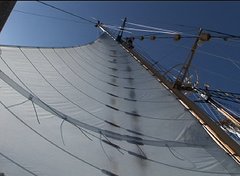 |
| The
view of Caroline Atoll from aloft (Photo by Meghan Shea) |
Caroline Atoll (also known as Millennium Atoll or Karoraina) is widely considered one of the most pristine reefs on the planet, inhabited for only a short fraction of its history and visited by few explorers, entrepreneurs, and scientists. And from our two days snorkeling on the fore reef, the characterization seems accurate—from almost 100% coral cover to dozens of shark sightings on every snorkel to over 100 feet of visibility, Karoraina was the most spectacular underwater ecosystem that I have ever had the opportunity to explore.
 |
| Caroline
Atoll, above and below water (Photo by Meghan Shea) |
If anything, the past several days have made me think about how extraordinarily lucky we are. It seems almost inconceivable that a large sailing vessel crewed in part by neophyte Stanford students could have made it to a remote coral atoll in the middle of the Pacific. We have seen a place on this planet that few have laid eyes on. We have snorkeled on reefs that even the most avid underwater explorers may never have a chance to visit.
So, I use these few words I have to the outside world to give thanks. To Captain Pamela, who against all odds found us a safe anchor on the steep slope of Karoraina so that every single person onboard could get in the water. To the entire crew of the Bobby C, who has kept us safe and challenged and fed (we love you, Vickie!). To the nation of Kiribati, for granting us passage through her waters. To everyone at SEA and Stanford who has contributed to making this experience possible. And to Caroline Atoll, for calm seas and manta rays and spectacular reefs and learning opportunities.
But more than that, we are standing on the shoulders of so many people who can’t be here with us—teachers, parents, siblings, friends, and mentors without whom we wouldn’t be on this adventure in the first place. I wish more than anything that I could share every moment of this voyage with all those who made it possible.
Sitting aloft yesterday and watching dolphins and sharks circle the ship as Caroline Atoll began to fade into the sunset, I couldn’t help laughing at how ridiculously surreal this whole journey has been. I am so humbled to be a member of this crew, a visitor to these places, and a student of this program.
Sending love and thanks and positive Pacific vibes,
-Meghan Shea


5 comments:
What a wonderful, wise post, Meghan! I'm so glad all you hard-working students were able to experience and appreciate the beauty of Karoraina.
Beautiful post! We're with all of you in spirit for sure :)
Your thoughtful post made it this time! Great to hear from you and the quick online surprise chat we had from Christmas Island! Hawaii bound!
Needless to say, I had to post this blog entry on Facebook, where it's getting rave reviews! Continue to savor your magical journey...
Very touching, Meghan! The rave reviews about Karoraina, Vickie's cooking, and Captain Pamela's piloting has got us sold!
Post a Comment